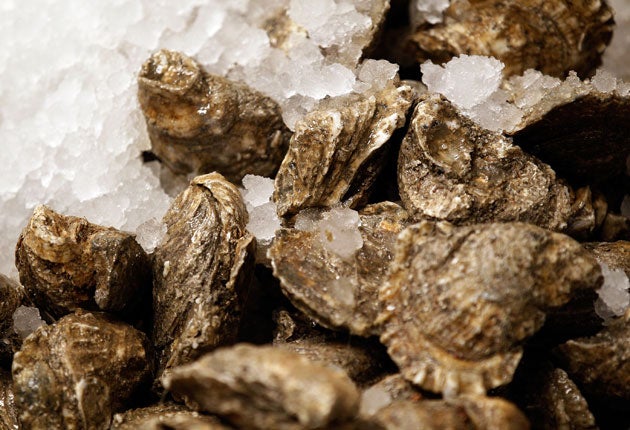Enjoy your shucking while it lasts. Wild oysters are now "functionally extinct" in many places around the world where they were once plentiful. More than 85 per cent of their reefs have been lost due to overfishing, according to a new study.
The decline of the mollusc is so severe that three-quarters of the world's remaining stock can be found in only five locations in North America. And in once famous harvesting locations such as Britain's Essex coast, the Wadden Sea off the Netherlands and Narragansett Bay, off Rhode Island, a mere 1 per cent of reefs remain. If nothing is done to protect remaining wild oysters, they could disappear within a generation, says Michael Beck of the University of California, Santa Cruz.
Dr Beck led a team of marine biologists who examined 144 former strongholds of the creatures in 40 regions around the world. The overall condition of the various species is "poor", concludes the largest ever investigation into wild oyster stocks, published this week in the journal BioScience. Their loss is important since they play a vital role in filtering impurities from sea water, supporting fish populations, and preventing coastal erosion.
Last summer's oil spill in the Gulf of Mexico hit the one place in the world native oyster catches had stayed at historical levels. The disaster destroyed as much as half of the most productive reefs, Dr Beck estimates.
"Oyster reefs are at less than 10 per cent of their prior abundance in most bays (70 per cent) and eco-regions (63 per cent)," reads his study. "They are functionally extinct, in that they lack any significant ecosystem role and remain at less than 1 per cent of prior abundances – in many bays (37 per cent) and eco-regions (28 per cent), particularly in North America, Australia and Europe."
The fate of wild oysters is starkly apparent when weighed against their role in history. During the time of the Roman Empire, they were abundant enough to keep the English Channel crystal clear. As recently as the late Victorian era, they were thought of as a staple food of the working class. In 1880, about 120,000 people worked as oyster-catchers in Britain alone, and the world consumed about 700 million native oysters each year.
Their populations were subsequently destroyed by modern fishing methods, most notably dredging, a method by which the entire ocean floor is effectively ripped up. The advent of global travel made things worse, since non-native species, and therefore diseases, were introduced to new regions. Today, almost all the oysters consumed in restaurants (except those from the Gulf of Mexico, where there are still wild catchers) are farmed, rather than wild.
"The loss of oysters tends to get ignored because most people have forgotten how abundant they once were," says Dr Beck. "In San Francisco in the 19th century, they were fed to workers building the transcontinental railroad. There were so many of them that the writer Jack London was both an oyster pirate and an oyster policeman. But today, there's not a single wild oyster bed in San Francisco Bay."
Oysters grow best in coastal regions where fresh water mixes with salt water. Over long periods of time, the shells of dead oysters build into reefs, which provide a valuable habitat for other fish and protect shorelines from erosion. But activity that damages parts of the reef leaves oysters vulnerable to stresses caused by changes in the environment.
In the Gulf of Mexico, many important reefs were destroyed last summer when clean-up workers decided to release vast amounts of fresh water from the Mississippi to help disperse oil spewing from BP's Deepwater Horizon rig. It changed salt concentrations and killed off as many as half the living oysters in some parts of the region.
Mr Beck recommends that all areas where less than 10 per cent of former wild oyster reefs remain should be closed to dredging, oyster harvesting and all activities that might harm stocks. "If we do nothing, then they could disappear," he says. "In many places, we've found that they are already functionally extinct. But if we act now, with reasonable measures, then I am confident that we can get them back."

Join our commenting forum
Join thought-provoking conversations, follow other Independent readers and see their replies
0Comments